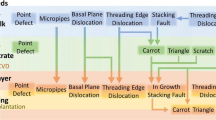Abstract
Plasma-assisted etching methods have been used in the manufacture of integrated circuits for more than 10 years and yet the surface-science aspects of this technology are poorly understood. The chemistry must be such that the reactive species generated in the plasma react with the surface being etched to form a volatile product. The chemistry is usually dominated by atoms, molecular radicals and low-energy (20–500 eV) positive ions. In microstructure fabrication, the positive ions are accelerated from the plasma towards the etched surface arriving essentially at normal incidence. Thus, the bottom surface of a very small feature being etched is subjected to both energetic ions and reactive neutral species, whereas the sidewalls of the feature are exposed to reactive neutral species only. The role of the energetic ions is primarily to accelerate the reaction between the neutral species and the etched surface (i.e., accelerate the etch rate), thereby reducing the steady-state top-monolayer coverage of the etching species on the etched surface. On the sidewalls, however, the reacting-species coverage is a saturation coverage. The present understanding of some of the surface-science aspects of this complex environment will be summarized, often using the Si-F system as an example, and some phenomena which are not well understood will be described.
Similar content being viewed by others
References
D.M. Manos, D.L. Flam (eds.): Plasma Etching (Academic, San Diego 1989)
N.G. Einspruch, D.M. Brown (eds.): VLSI Electronics — Microstructure Science Vol. 8 (Academic, Orlando 1984)
J.L. Elking, G.J. Orloff: J. Vac. Sci. Technol. A 10, 1106 (1992)
N. Hosokawa, R. Matsuzaki, T. Asamaki: Jpn. J. Appl. Phys. Suppl. 2, Part 1, 435 (1974)
L. Holland, S.M. Ojha: Vacuum 26, 53 (1976)
G.C. Schwartz, L.B. Zielinski, T. Schopen: In Etching, ed. by M.J. Rand, H.G. Hughes, Electrochem. Soc. Symp. Ser. (Electrochem. Soc., Princeton, NJ 1976) p. 122
J.W. Coburn, H.F. Winters: J. Appl. Phys. 50, 3189 (1979)
U. Gerlach-Meyer, J.W. Coburn, E. Kay: Surf. Sci. 103, 177 (1981)
Y.Y. Tu, T.J. Chuang, H.F. Winters: Phys. Rev. B 23, 823 (1981)
J.M. Cook, K.G. Donohoe: Solid State Technol. 34-4, 119 (1991)
D.L. Flamm: Solid State Technol. 34-3, 47 (1991)
H.F. Winters: J. Appl. Phys. 49, 5165 (1978)
D.L. Flamm, V.M. Donnelly: Plasma Chem. Plasma Process. 1, 317 (1981)
J.L. Mauer, J.S. Logan, L.B. Zielinski, G.C. Schwartz: J. Vac. Sci. Technol. 15, 1734 (1978)
H.F. Winters, J.W. Coburn: Surf. Sci. Rep. 14, 161 (1992)
F.R. McFeely, J.F. Morar, F.J. Himpsel: Surf. Sci. 165, 277 (1986)
H.F. Winters, J.W. Coburn: J. Vac. Sci. Technol. B 3, 1376 (1985)
D.J. Oostra, A. Haring, A.E. de Vries, F.H.M. Sanders, G.N.A. van Veen: Nucl. Instrum. Methods B 13, 556 (1986)
K. Affolter: J. Vac. Sci. Technol. B 7, 19 (1989)
E.L. Barrish, D.J. Vitkavage, T.M. Mayer: J. Appl. Phys. 57, 1336 (1985)
H.F. Winters: J. Appl. Phys. 64, 2805 (1988)
J.W. Coburn, H.F. Winters: J. Vac. Sci. Technol. 16, 391 (1979)
H.F. Winters: J. Vac. Sci. Technol. B 3, 9 (1985)
D.L. Smith, R.H. Bruce: J. Electrochem. Soc. 129, 2045 (1982)
H.B. Pogge, J.A. Bondur, P.J. Burkhardt: J. Electrochem. Soc. 130, 1592 (1983)
D.J. Thomas, P. Southworth, M.C. Flowers, R. Greef: J. Vac. Sci. Technol. B 7, 1325 (1989)
J.W. Coburn: J. Vac. Sci Technol. A 12, 617 (1994)
T.P. Chow, G.M. Fanelli: J. Electrochem. Soc. 132, 1969 (1985)
G. Fortuno: Plasma Chem. Plasma Process. 8, 19 (1988)
S. Tachi, K. Tsujimoto, S. Okudaira: Appl. Phys. Lett. 52, 616 (1988)
J.W. Coburn, C.B. Mullins: In Proc. 9th Symp. on Plasma Processing, Vol. 92–18 (Electrochem. Soc., Pennington, NJ 1992) p. 276
R.E. Walkup, K.L. Saenger, G.S. Selwyn: J. Chem. Phys. 84, 2668 (1986)
S. Fujimura, K. Shinagawa, M. Nakamura, H. Yano: Jpn. J. Appl. Phys. 29, 2165 (1990)
J.P. Booth, N. Sadeghi: J. Appl. Phys. 70, 611 (1991)
G.W. Grynkewich, T.H. Fedynyshyn, R.H. Dumas: J. Vac. Sci. Technol. B 8, 5 (1990)
T.H. Fedynyshyn, G.W. Grynkewich, B.A. Chen, T.P. Ma: J. Electrochem. Soc. 136, 1799 (1989)




